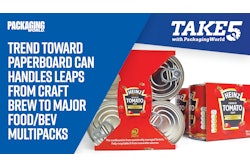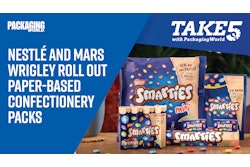Quick hits:
- Edible packaging appears in several niche formats, from fruit skin-based frozen yogurt ’skin’ applications to rice paper in candy, but it largely has been off the beaten packaging path.
- A lot of recent momentum has occurred around flexible films based on plant proteins, usually seaweed, as a means to carry liquids and sauces.
- A new application by meal kit brand Gousto Recipe Box trials a vegan pea protein film, made using starch and vinegar (that doesn’t end up in the final film), that carries a powdered stock/boulion cube. The cube, packaging and all, can be simply dissolved in warm water and added to the meal.
- Meal Kit Brand Tests ‘World’s First’ Edible, Dissolvable Flexible Film Made from Pea Protein
- Seaweed-based Sauce Sachet Trials in the U.K.
- Research Evaluates the Use of Milk Proteins for Packaging Film
- Whiskey Pods Use Algae Film Casing
- Read PMMI's report on the drive toward 4.0 connectivity in packaging and processing.
 | Read the transcript below: |
Hello, I'm Matt Reynolds, editor of Packaging World Magazine back with another addition of Take Five with Packaging World.
As you likely know, we cover a lot of sustainability trends in packaging here at Packaging World and on this format, on Take Five. There's simply a lot of movement in this area and there's a lot to cover and there's a lot of different ways that you can categorize or dice up exactly what's going on out there. Most of it is working towards what we would call a circular economy, where you either have a durable or a recyclable package, that at the end of a product's life cycle is in a circular fashion sucked back up into the value stream to be used either again as the package itself in a durable refillable fashion or as recyclable material. Perhaps moving from a multilayer unrecyclable to a recyclable monolayer or a single layer material that can then be easily recycled and turned back into packaging and not down cycled into something different, but back into packaging in a circular fashion.
Another way of going about sustainability leaves no packaging at all at the end and this comes into the realm of biodegradable packaging that might still go to landfill, but won't last there for untold number of years, it will degrade into something as basically a mulch. Then there's compostability, which is another way, it's within the realm of biodegradable that can be done at an industrial scale or it can be done in the backyard even.
Now there's some limitations there because this is packaging that is designed to A, protect what its contents are, but B degrade over time, so naturally the adoption and the number of applications are going to be limited. One in particular really grabbed some headlines and it's really interesting within the auspices of biodegradable packaging, although we know recognize that the application range is probably limited and that is the dream of edible packaging.
A few-semi recent innovation in this category, one about seven years ago was from Stony Field Organics and they have frozen yogurt pearls and this was a package design made by Wiki Foods that uses organic fruit skins to accomplish the protection of the Froyo, the frozen yogurt that's inside and then that's easily digestible by the human body and there's no packaging at the end.
More recently making a splash at the London Marathon has been a company called Notpla and I believe a predecessor called Skipping Rock Labs, I believe they're related, I'm not exactly sure how, but they have a product called Ooho. I probably am mispronounced thing that, but is essentially a seaweed based film, a flexible film based on seaweed that can contain liquids like water or a sports drink. Well, these were being passed out in the London marathon.
So we'll see what the applications are available for that one in the long term but another really interesting one just came up in a commercialized setting. If you're like me, you've been experimenting with some of the meal kit brands, here in the US we have Hello Fresh, Blue Apron and so on. A downside to these formats as convenient as they are is that we get packaging for single unit or single dose sizes of spices and ingredients saffron for instance, it would be expensive for me to buy a whole jar of saffron and in fact, it would also be wasteful for me to buy a whole jar that I only use a pinch of. The downside of that on the meal kit side is then you have a package that's only yay big, and then consumers are exposed to quite a bit more packaging than they would believe they otherwise needed. So recognizing this was a British meal kit brand called Gusto Recipe box.
So they partnered with a company called Xampla. Xampla is a mission based commercial spinoff of Cambridge, the famous university in the UK that actually uses a pea based protein that's spread out into sheets using a starch and also a vinegar in the process, although there's no vinegar in the actual product itself, to create a P based protein film. So this film is able to be used for bullion cubes, stock cubes that are in the meal kit. So instead of a consumer taking the stock cube out of a film package, or what Gusto had been previously using, which is the sachet style pack, the pack itself is made of a pea based protein that can be simply dissolved in water. So the user just drops it into hot water, the package and its contents dissolved together and you of your soup stock in this case, it's for a carrot and lintel product from Gusto Recipe Box.
I spoke via email with Simon Hombersley he's Xampla's CEO and he emphasized that this application was a bespoke project, which means the film designed here was designed specifically for this dry bullion or stock cube application. So naturally there's not a ton of barrier properties that are necessary for this application, it's really quite low hanging fruit for this pea protein based film. This project is currently in beta testing in the UK right now, as we speak in November 2021, for Gusto Recipe Box customers that have opted in to give this a try and to kick the tires and see how it works. Now, Hombersley mentioned that a further of 17 British tons or 18.8 US tons of plastic could be saved by Gusto annually if the new edible stock pack were rolled out across this entire portfolio.
So a lot of interesting things in edible packaging happening now, it's not going to happen immediately, it's going to be a slow adoption curve and a very limited range of applications, but still really interesting headline grabbing stuff.
























